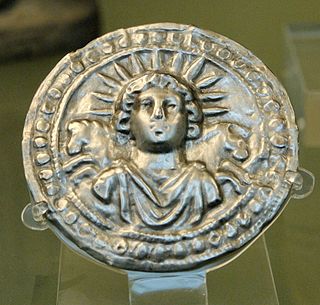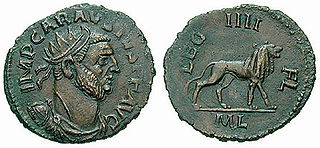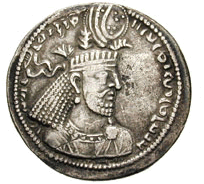The 300s decade ran from January 1, 300, to December 31, 309.
The 320s decade ran from January 1, 320, to December 31, 329.

Year 321 (CCCXXI) was a common year starting on Sunday of the Julian calendar. In the Roman Empire, it was known as the Year of the Consulship of Crispus and Constantinus. The denomination 321 for this year has been used since the early medieval period, when the Anno Domini calendar era became the prevalent method in Europe for naming years.

Year 286 (CCLXXXVI) was a common year starting on Friday of the Julian calendar. At the time, it was known as the Year of the Consulship of Maximus and Aquilinus. The denomination 286 for this year has been used since the early medieval period, when the Anno Domini calendar era became the prevalent method in Europe for naming years.

Year 325 (CCCXXV) was a common year starting on Friday of the Julian calendar. At the time, it was known as the Year of the Consulship of Proculus and Paulinus. The denomination 325 for this year has been used since the early medieval period, when the Anno Domini calendar era became the prevalent method in Europe for naming years.

Year 451 (CDLI) was a common year starting on Monday of the Julian calendar. At the time, it was known as the Year of the Consulship of Marcianus and Adelfius. The denomination 451 for this year has been used since the early medieval period, when the Anno Domini calendar era became the prevalent method in Europe for naming years.
The 330s decade ran from January 1, 330, to December 31, 339.
The 290s decade ran from January 1, 290, to December 31, 299.
The 280's decade ran from January 1, 280, to December 31, 289.

Year 386 (CCCLXXXVI) was a common year starting on Thursday of the Julian calendar. At the time, it was known as the Year of the Consulship of Honorius and Euodius. The denomination 386 for this year has been used since the early medieval period, when the Anno Domini calendar era became the prevalent method in Europe for naming years.

Year 295 (CCXCV) was a common year starting on Tuesday of the Julian calendar, the 295th Year of the Common Era (CE) and Anno Domini (AD) designations, the 295th year of the 1st millennium, the 95th year and last 6 years of the 3rd century, and the 6th year of the 290s decade. At the time, it was known as the Year of the Consulship of Tuscus and Anullinus. The denomination 295 for this year has been used since the early medieval period, when the Anno Domini calendar era became the prevalent method in Europe for naming years.
Year 294 (CCXCIV) was a common year starting on Monday of the Julian calendar. At the time, it was known as the Year of the Consulship of Constantius and(Galerius) Maximianus. The denomination 294 for this year has been used since the early medieval period, when the Anno Domini calendar era became the prevalent method in Europe for naming years.

Year 293 (CCXCIII) was a common year starting on Sunday of the Julian calendar. In the Roman Empire, it was known as the Year of the Consulship of Diocletian and Maximian. The denomination 293 for this year has been used since the early medieval period, when the Anno Domini calendar era became the prevalent method in Europe for naming years.

Year 335 (CCCXXXV) was a common year starting on Wednesday of the Julian calendar. At the time, it was known as the Year of the Consulship of Constantius and Albinus. The denomination 335 for this year has been used since the early medieval period, when the Anno Domini calendar era became the prevalent method in Europe for naming years.

Year 320 (CCCXX) was a leap year starting on Friday of the Julian calendar.

Year 316 (CCCXVI) was a leap year starting on Sunday of the Julian calendar. At the time, it was known as the Year of the Consulship of Sabinus and Rufinus. The denomination 316 for this year has been used since the early medieval period, when the Anno Domini calendar era became the prevalent method in Europe for naming years.

Prince or King of Dai was an ancient and medieval Chinese title.

Dai, also rendered as Tai and sometimes known in historiography as the Tuoba Dai, was a dynastic state of China ruled by the Tuoba clan of Xianbei descent, during the era of Sixteen Kingdoms. It existed from AD 310 to 376, with its capital at Shengle.
Tuoba Shiyiqian was the last prince of the Xianbei-led Dai dynasty of China and ruled from 338 to 376 when Dai was conquered by the Former Qin dynasty. He was the son of Tuoba Yulü and the younger brother of Tuoba Yihuai, whom he succeeded in 338. In 340 he moved the capital to Shengle (盛樂). His grandson Tuoba Gui later founded the Northern Wei dynasty and accorded him the posthumous name Emperor Zhaocheng (昭成皇帝) and the temple name Gaozu (高祖).
Tuoba Yihuai ruled as prince of the Tuoba Dai from 329 to 335 and again from 337 to 338. He was the son of Tuoba Yulü and the nephew of Tuoba Hena. When Tuoba Hena was in his first reign as the Prince of Dai, Tuoba Yihuai lived with his maternal uncle's father Helan Aitou (賀蘭藹頭) of the Helan tribe.












